ABSTRACT:
Internet of Things (IoT), a widely known branch of computer science has introduced
sensible farming to every farmer’s neighborhood and also providing constructive inexperienced
agriculture. For the past few years, the agriculture field is facing lots of challenges like climatic
condition instability, improper cropping pattern and lagging techniques in farming. IoT helps in
farming by self-configuring chain of parts. The economical implementation helps agriculture, by
reducing human work and increasing crop cultivations. This paper endorses smart IoT primarily
based Agriculture Stick as farmers aid by getting Live information (Temperature, Soil Moisture)
of farm information. These live readings facilitate the farmers to undertake clever farming and to
extend their average crop yields, conjointly the standard of plants.The sensible Agriculture with
Arduino Technology supports the farmers to regulate the live farm data and obtain the required
crop cultivation results.
Keywords: Agriculture, Data collection, Environmental sensing, Internet of things, Monitoring,
Smart Farming.
INTRODUCTION:
Farming land may be a precious resource, it's necessary for the survival of fashionable
society. However such a large amount of challenges are long-faced in agricultural farming, you
wish to induce the temperature, wetness and daylight right for the crop, then you have got to
confirm that nothing destroys the crop.
The idea of sensible farming has been taking form within the recent years, the thought of
remotely overseeing the state of your crop. However this revolution in farming comes at a good
price, most accessible systems are too expensive to implement on little farms and therefore the
systems might not cowl giant farms. SmartAgro intends to form a network of devices,
straightforward to use that may be placed on the sphere that's being monitored. The devices
collect region information, soil connected parameters and light-weight values, causing all the
information to the cloud wherever it's conferred on a dashboard. This allows any farm, any size
to run into the new age of farming, implementing a scalable fleet of devices across their land that
may warn them if a drought is approaching.
LITERATURE SURVEY:
A system using faraway sensors that screen exceptional situations of stages of setting like
water degree, humidity, temperature, movement of animals, moisture content in soil, and so on.
The Arduino UNO model at the side of GSM defend is employed. The field state of affairs is
dispatched to the farmer through mobile text messages. With this machine, sensor node failure
and electricity saving are controlled. A machine is planned for smart agriculture monitoring
based mostly completely on the IoT era. The machine plays statistics shooting, processing,
transmission and reception functions. The aim of their experiments is to realize a sensible
agriculture device, during which the machine efficiency is to manage the environment region and
lower the money and farming fee and conjointly saves electricity. In a nutshell, the layout
realizes faraway clever pursuit and control of environmental conditions and in addition replaces
the standard stressed generation to Wi-Fi, also reduces hands value. A system is planned
for crop growth which might be monitored victimization thermal imaging technique. Here, the
irrigation temperature distribution size (ITDM) technique has been placed into movement. In
actual time, the captured data comprising captured values offers higher irrigation. An approach
to assess victimization Wi-Fi module networks used in implementing automating farm
systems and facts are conveyed to Arduino via voice communication. The various sensors are
enforced and used to expertise the temperature measurement, humidness measuring, moisture
measurement and hindrances for the crop tracking. when the brink values go below then only
warning is given by device. The farmer is employed to be parallelly attached to the situations of
the field. It additionally describes field framings. Moderate depth management can also be
processed additionally to irrigation. Here, the forecast of crop quality still has water
necessities likewise that are abundant well organized. The IoT SMS alarm device is
incorporated via GSM shield.
The device will capture environmental parameters on with temperature of air and wetness
of air. In short time, with the employment of AT command, this widget can even notice SMS
automatic causation and receiving, environmental situations overrun alarm and inadequate
balance alarm. Through the device swing, the messages are often sent to the user-special cellular
wireless telephone mechanically no matter what the customer's place is. This widget as a
standard application of IoT within the agriculture has some efficient consequences within the
real operation. R. Suresh et al. mentions, close to victimisation automated microcontroller
primarily based rain gun irrigation system in which the irrigation can turn up only if there might
be intense demand of water that store an enormous quantity of water. These structures convey a
trade to management of subject area during which they developed a Android software system
stack. This stack includes a operating device, middleware and key packages. The automaton
SDK supports the instrumentality and arthropod genus got to begin growing programs at the
automaton systems victimisation Java programing language. Mobile phones have come back to
be very important and essential a part of United States of America providing more than one
desires of humans. This application uses the GPRS operate of cellular phone as an answer for
farm manipulated machine. These gadgets blanketed a little vary of agricultural land and were
not economically inexpensive. Indu et al. especially focused on reviews among the discipline
of remote observation and manipulation, the era used and its capability blessings. This paper
version proposes protection of GSM/Bluetooth primarily based whole human controlled
faraway for irrigation machine. This device has set the irrigation time relying at the temperature
and wetness reading obtaining from sensors and specific sorts of crops and would possibly
mechanically irrigation the sector while needed. Information is changed between some distance
issue and designed system through SMS on GSM community. A Bluetooth module is
additionally hooked up with the principle microcontroller chip which provides a message when
the buyer or the farmer is within the forced variety of little meters to the distanced widget. The
system gives statistics to the users or farmers regarding several conditions like quality of
increased temperature, water content material in soil and smoke via SMS on GSM network or via
Bluetooth is completed 98.50% accurately from alternative machine learning algorithms.
PROPOSED TECHNOLOGY:
SmartAgro permits the user to easily implement a fleet of devices on the sphere that is
being monitored. These devices take samples from the sensors at outlined intervals of your time.
The info is then logged to a.csv file on the memory card and sent to the backend wherever the
info is pictured on a dashboard. The project consists of a front-end and a backend.
Front-End:
The front-end of the project refers to the physical devices placed on the world. These
devices take samples of data from their sensors, burning them to memory cards and sending the
data to the backend.
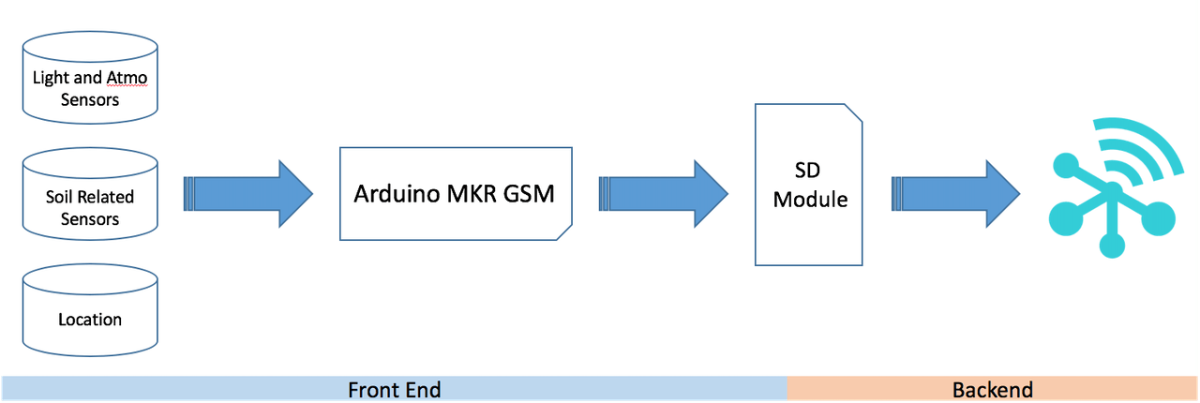
PROPOSED WORK:
An MKR GSM is employed for the front-end, the device collects the information so
sends it to Soracom, wherever it's pictured. Below area unit the steps taken by the device once
assembling information.
The device starts in setup mode, here it prepares all the sensors and gets a location fix.
The device then checks to check if there's already a file to burn to on the memory card, if
a file is obtainable, it'll append thereto, otherwise, the device can produce a file and append
thereto. The device then takes samples from all its sensors, it measures atmospheric temperature
and wetness, soil wetness and temperature and actinic radiation index, lightweight|light|visible
radiation|actinic radiation|actinic ray} and IR light. These values are then kept on the device.
The MKR GSM module then prepares the data for burning it to the memory card, then it
compiles the data into a string that represents a line of a.csv file.
The data is then burned to the Coyote State card. All the values are then ready to be sent
to Soracom through GSM. the info is compiled into a JSON buffer. The info is then sent to the
backend by the device. The device currently goes into sleep mode for an outlined quantity of
your time and can repeat the method once it wakes up.

SD-Card:
The device can log the information non-heritable from the sensors to the memory card
connected to it. The data is going to be appended to a.csv file that may then be downloaded. In
the setup, the device locates if a.csv file to jot down is out there and can append to that if it
already exists. it'll produce a replacement file if one doesn't exist. Below are some pictures of the
file.

Battery:
The device is high-powered through multiple ways in which. It is high-powered by a
LiPo battery through the provided port on the device, by an influence bank or by connecting
battery through the VIN port on the device. The period of time of the device heavily depends on
the facility of the battery. The device goes into sleep mode between reads to conserve the
maximum amount of energy as attainable.
Data Send:
The data is distributed to Soracom through a GSM association to the server. The
information is distributed as a JSON payload. This info is then received by the backend and is
then processed.
Backend:
The backend of the application refers to Soracom. The data is received by Soracom,
processed then displayed on the dashboard. Data is received by Soracom through Soracom Air
The data is then collected by Soracom Harvest The data is finally queried by Soracom Lagoon at
intervals of your time that then displays the information on a dashboard.

The Dashboard:
The dashboard for this project is hosted on Soracom lagoon. The data is received by
Soracom Air within the backend, Soracom Harvest collects the data so lagoon queries it from
Harvest. The location of every device within the fleet and every one sensor information is
premeditated on the dashboard. Screenshots of the dashboard are below.
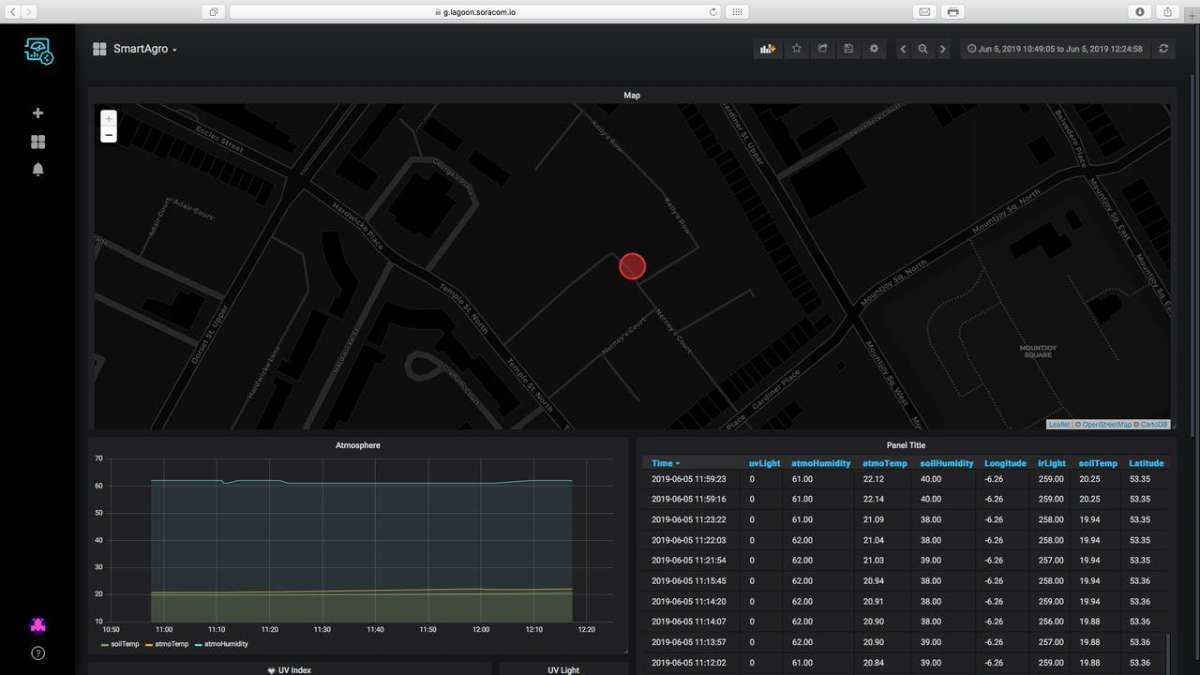
The user also can set the backend to receive email notifications if the ultraviolet radiation
index or soil humidness collected by the device are abnormal. This way, the user can grasp if the
crops would like attention.
The user operating this project can have several benefits:
● Visualize data on the go at any time, anyplace using the dashboard.
● Easily proportion the devices and use as multiple.
● Lower prices than usual solutions on the market.
CONSTRUCTING THE SYSTEM:
Step 1: (Required Apparatus)
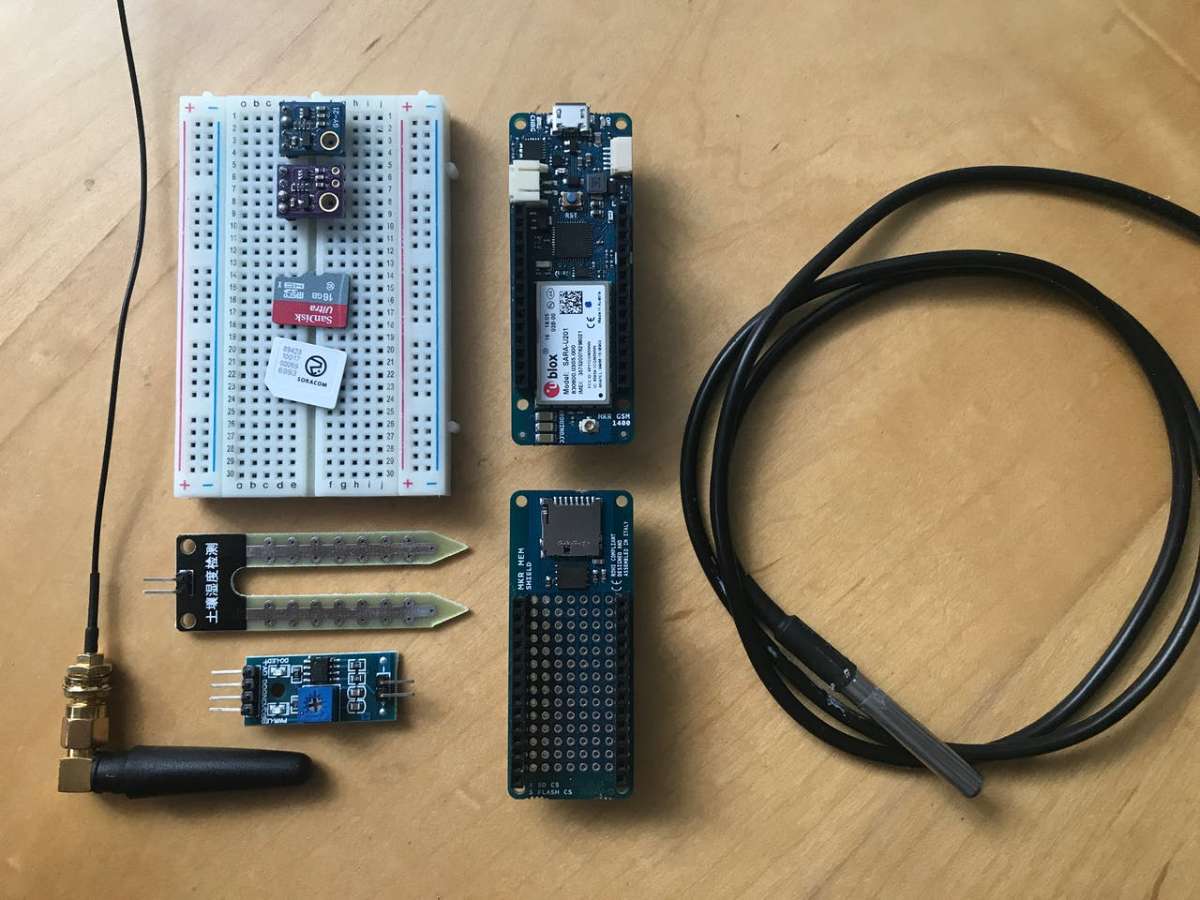
Step 2: Connecting the Circuit
A hand tool is required to solder all the parts along. The schematics are illustrated within
the fritzing file below. Remember to connect the mem shield to the board.
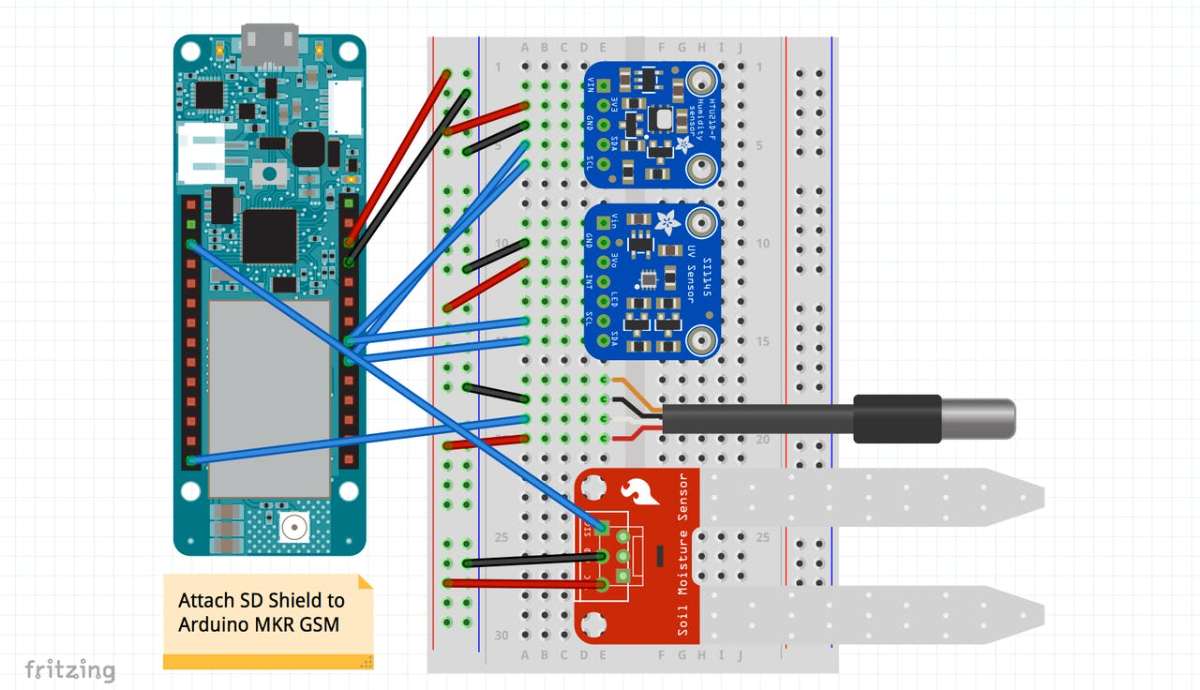
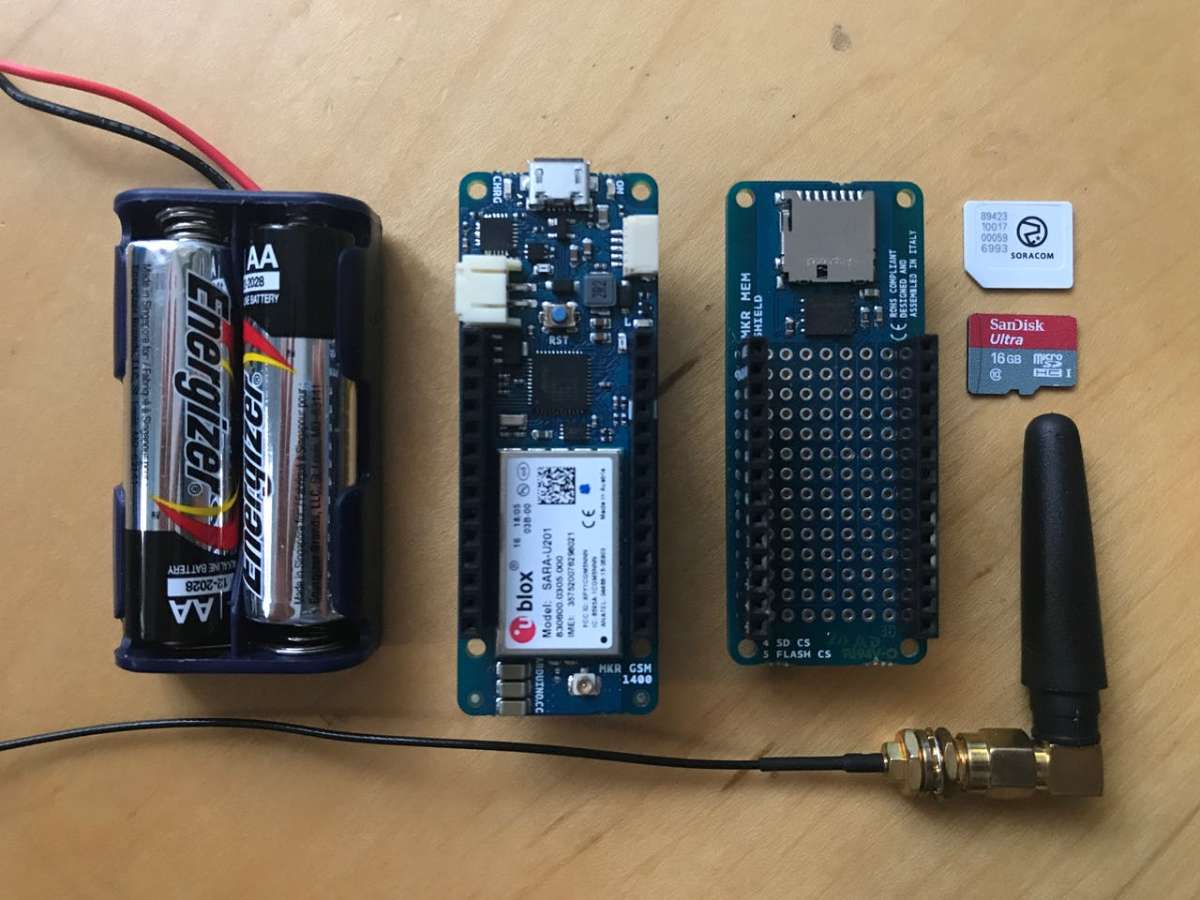
Preparing the MKR GSM
The Arduino MKR GSM must be ready. I battery-powered the board with 2 AA batteries
through the VIN port.
Step 3: Acknowledging the Code
There are four main sections to the code used for the project.
● Prepare SD
The checkFile() operate checks if the.csv file that the device is supposed to append to
exists. If the file exists, the function ends, otherwise it calls on createFile() which creates
a new.csv file to append to.
● Collect Data
This section of code collects the data from all the sensors on board. It contacts sensors for
region temperature and wetness, soil humidness and temperature and UV index, IR
light-weight worth and visual light-weight.
● Burn Data to SD
This operation burns the info that was antecedently compiled into a line of a.csv file to
the memory card. The info is appended to the file on the cardboard.
● Send Data to Soracom
Finally, the info is shipped to Soracom. The device establishes a reference to the server
so prepares the credentials. The data is then sent to the server and also the response is
written to the Serial Monitor. The device then goes to sleep for an outlined quantity of
your time and continues the steps once more.
Step 4: Setting Up the Variables
A few variables need to be altered by the user before the project may be used. The
variables that are editable are within the computer file of the code. These are represented below.
● DeviceName:
DeviceName is the custom name of the device. This is often sent along-side the payload
to Soracom, it's helpful to spot devices apart once managing a fleet of devices.
● SleepTime:
SleepTime is that the quantity of your time (in milliseconds) that the device can sleep for
between reads. The device can visit sleep between reads to cut back the battery
consumed. proDebug is ready to true if bugging and to false otherwise.
● ProDebug:
ProDebug is enabled, the device needs to be connected to a pc with the serial monitor on
to figure. Set to true once debugging however guarantee it's set to false if it's on the
sphere. Note that the device can still print to the serial even though proDebug is false;
Step 5: Setting Up the SD Card
The memory card must be ready before it is often used with the device. The memory card
must be formatted as FAT 32.
Step 6: Upload the Code
Before fixing the backend, data must be sent to that. If you don,t have a Soracom account
and therefore the SIM you're victimisation isn't registered, you'll have to be compelled to
complete step 7 first. To do this, connect your MKR GSM module to your pc and transfer the
code to the device, make sure that the mode of the device is about to one for this setup. Once the
code has uploaded, place all the sensors in water. Now press the button on the device and await
the information to gather and send. Repeat this some of the time to populate Soracom Air.
Step 7: Setting Up Soracom
This step is split into two sections, the primary will cover creating an account with
Soracom and registering your SIM whereas the opposite will cover fixing Soracom Harvest to
gather the info from Air. If you have already got AN account with Soracom, skip the primary
section.
● Section 1: Creating an Account
● Section 2: Groups and Harvest
Step 8: Setting Up Soracom Lagoon
The very last thing to set up on Soracom is lagoon, this is often the tool that we are going
to use to visualise our data and build email alerts if the data isn't sensible.
CONCLUSION
Finally we designed an enclosure for the project, it might be desirable if the highest of the
enclosure would be clear so the ultraviolet detector are often placed inside the enclosure, we
placed our detector outside the enclosure to stop any interference. Finally, make sure that all the
variables are set and so place the device on the sphere, it ought to be able to monitor all
parameters currently. Using an SD Card Module we have chosen to use the Arduino MKR mem
shield because it is straightforward to use and quite compact. AN SD card module also {can|can
even|may also|may} be used tho' most operate with 5v whereas the MKR GSM can only give
3.3v, so level converter is required to accelerate the 3.3v to 5v.The planned assignment is also
additional larger with the help of together with a pump to the machine to facilitate processed
irrigation. The automatic irrigation device is also triggered when soil wet content goes beneath
the brinkstage. The threshold degree will be determined within the written Arduino code. The
idea of the usage of IOT for irrigation will be prolonged additionally to different tasks in farming
along with farm animal management, fire detection and climate management. This could limit
human intervention in farming sports.